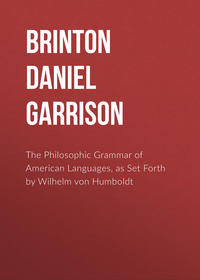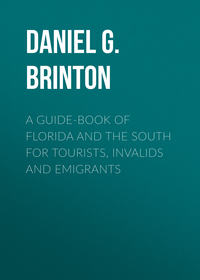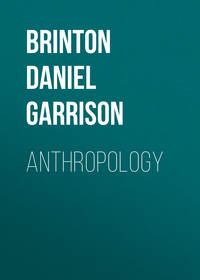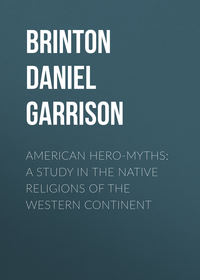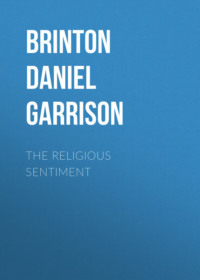 полная версия
полная версияNotes on the Floridian Peninsula; its Literary History, Indian Tribes and Antiquities
Besides this, there is a letter from a volunteer of Rouen to his father, without name or date.31 Interior evidence, however, shows it was written during the summer of 1564, and sent home by the return vessels which left Florida on the 28th July of that year. This was the earliest account of the French colony printed on the continent. Its contents relate to the incidents of the voyage, the manners of the “sauvages,” and the building of the fort, with which last the troops were busied at the time of writing.
This and Ribaut’s report made up the scanty knowledge of the colonies of Coligny to be found in Europe up to the ever memorable year 1565; memorable and infamous for the foulest crime wherewith fanaticism had yet stained the soil of the New World; memorable and glorious, for in that year the history of our civilization takes its birth with the first permanent settlement north of Mexico. Two nations and two religions came into conflict. Fortunately we are not without abundant statements on each side. Five eyewitnesses lived to tell the world the story of fiendish barbarity, or divine Nemesis, as they variously viewed it.
On the former side, the third and last letter of Laudonniére is a brief but interesting record. Simple, straightforward, it proves him a brave man and worthy Christian. He lays much blame on the useless delay of Ribaut, and attributes to it the loss of Florida.
Much more complete is the pleasing memoir of N. C. Challeux (Challus, Challusius.)32 He tells us in his dedicatory epistle that he was a native of Dieppe, a carpenter by trade, and over sixty years of age at the time of the expedition. In another passage he remarks, “Old man as I am, and all grey.”33 He escaped with Laudonniére from Fort Caroline, and depicts the massacre and subsequent events with great truth and quaintness. He is somewhat of a poet, somewhat of a scholar, and not a little of a moralizer. At the beginning of the first edition are verses descriptive of his condition after his return, oppressed by poverty, bringing nought from his long rovings but “a beautiful white staff in his hand.” “The volume closes with another effusion of his muse, expressing the joy he felt at again beholding his beloved city of Dieppe.”34 He is much given to diverging into prayers and pious reflections on the ups and downs of life, the value of contentment, and kindred subjects, seasoning his lucubrations with classical allusions.
When Laudonniére was making up the complement of his expedition he did not forget to include a cunning limner, so that the pencil might aid the pen in describing the marvels of the New World he was about to visit. This artist, a native of Dieppe, Jacques le Moyne de Morgues by name, escaped at the massacre by the Spanish, returned with Laudonniére, and with him left the ship when it touched the coast of England. Removing to London he there married, and supported himself by his profession. During the leisure hours of his after years he sketched from memory many scenes from his voyage, adding in his native language a brief description of each, aiding his recollection by the published narratives of Challeux and Laudonniére, duly acknowledging his indebtedness.35 These paintings were familiar to Hackluyt, who gives it as one reason for translating the collection of Basanier, that the exploits of the French, “and diver other things of chiefest importance are lively drawn in colours at your no smal charges by the skillful painter James Morgues, sometime living in the Blackfryers in London.”36 When the enterprising engraver De Bry came to London in 1587, intent on collecting materials for his great work the Peregrinationes, he was much interested in these sketches, and at the death of the artist, which occurred about this time, obtained them from his widow with their accompanying manuscripts. They are forty-three in number, principally designed to illustrate the life and manners of the natives, and, with a map, make up the second part of De Bry’s collection. Each one is accompanied by a brief, well-written explanation in Latin, and at the close a general narrative of the expedition; together, they form a valuable addition to our knowledge of the aboriginal tribes and the proceedings of the Huguenots on the Riviére Mai.
The Spanish accounts, though agreeing as regards the facts with those of their enemies, take a very different theoretical view. In them, Aviles is a model of Christian virtue and valor, somewhat stern now and then, it is true, but not more so than the Church permitted against such stiff necked heretics. The massacre of the Huguenots is excused with cogent reasoning; indeed, what need of any excuse for exterminating this nest of pestilent unbelievers? Could they be ignorant that they were breaking the laws of nations by settling on Spanish soil? The Council of the Indies argue the point and prove the infringement in a still extant document.37 Did they imagine His Most Catholic Majesty would pass lightly by this taunt cast in the teeth of the devoutest nation of the world?
The best known witness on their side is Don Solis de Meras. His Memorial de todas las Jornadas y Sucesos del Adelantado Pedro Menendez de Aviles, has never been published separately, but all the pertinent portions are given by Barcia in the Ensayo Cronologico para la Historia de la Florida, with a scrupulous fidelity (sin abreviar su contexto, ni mudar su estilo). It was apparently written for Aviles, from the archives of whose family it was obtained by Barcia. It is an interesting and important document, the work of a man not unaccustomed to using the pen.
Better than it, however, and entering more fully into the spirit of the undertaking, is the memoir of Lopez de Mendoza Grajales,38 chaplain to the expedition, and a most zealous hater of heretics. He does not aim at elegance of style, for he is diffuse and obscure, nor yet at a careful historical statement, for he esteems lightly common facts, but he does strive to show how the special Providence of God watched over the enterprise, how divers wondrous miracles were at once proof and aid of the pious work, and how in sundry times and places God manifestly furthered the holy work of bloodshed. A useful portion of his memoir is that in which he describes the founding of St. Augustine, entering into the movements of the Spaniards with more detail than does the last-mentioned writer.
When the massacre of the 19th September, 1565, became known in Europe, “the French were wondrously exasperated at such cowardly treachery, such detestable cruelty.”39 Still more bitterly were they aroused when they learned the inexcusable butchery of Ribaut and his men. These had been wrecked on the Floridian shore, and with difficulty escaped the waves only to fall into the hands of more fell destroyers on land. When this was heard at their homes, their “widows, little orphan children, and their friends, relatives and connections,” drew up and presented to Charles IXL., a petition,40 generally known as the Epistola Supplicatoria, setting forth the facts of the case and demanding redress.
Though the weak and foolish monarch paid no marked attention to this, a man arose who must ever be classed among the heroes of history. This was Dominique de Gourgues, a high born Bourdelois, who, inspired with an unconquerable desire to wreak vengeance on the perpetrators of the bloody deed, sold his possessions, and by this and other means raised money sufficient to equip an expedition. His entire success is well known. Of its incidents, two, histories are extant, both by unknown hands, and both apparently written some time afterwards. It is even doubtful whether either writer was an eyewitness. Both, however, agree in all main facts.
The one first written and most complete lay a long time neglected in the Bibliotheque du Roi.41 Within the present century it has been twice published from the original manuscript. It commences with the discovery of America by Columbus; is well composed by an appreciative hand, and has a pleasant vein of philosophical comment running throughout. The details of the voyage are given in a careful and very satisfactory manner.
The other is found in Basanier, under the title “Le Quatrièsme Voyage des François en la Floride, sous le capitaine Gourgues, en l’an 1567;” and, except the Introduction, is the only portion of his volume not written by Laudonniére. By some it is considered merely an epitome of the former, but after a careful comparison I am more inclined to believe it writen by Basanier himself, from the floating accounts of his day or from some unknown relator. This seems also the opinion of his late editor.
The manuscript mentioned by Charlevoix as existing in his day in the family of De Gourgues, was either a copy of one of these or else a third of which we have no further knowledge.
Other works may moulder in Spanish libraries on this part of our narrative. We know that Barcia had access to certain letters and papers (Cartas y Papeles) of Aviles himself, which have never been published, and possessed the original manuscripts of the learned historiographer Pedro Hernandez del Pulgar, among which was a Historia de la Florida, containing an account of the French colonies written for Charles II. But it is not probable that these would add any notable increment to our knowledge.
The Latin tract of Levinus Apollonius,42 of extreme rarity, a copy of which I have never seen, is probably merely a translation of Challeux or Ribaut, as no other original account except the short letter sent to Rouen had been printed up to the date of its publication. This Apollonius, whose real name does not appear, was a German, born near Bruges, and died at the Canary Islands on his way to America. He is better known as the author of De Peruviæ Inventione, Libri V., Antwerpiæ, 1567,43 a scarce work, not without merit. On the fly-leaf of the copy in the Yale College library is the following curious note:
“Struvius in Bibl. Antiq. hunc librum laudibus affert; et inter raros adnumerant David Clement, Bibl. Curieuse, Tom. I.; pag; 403, Jo. Vogt, Catal; libror; rarior; pag; 40, Freytag in Analec; Literar; pag; 31.”
Some hints of the life of Levinus may be found in his Epistola Nuncupatoria to this work, and there is a scanty article on him in the Biographie Universelle.
A work of somewhat similar title44 was published in 1578 by Vignon at Geneva appended to Urbain Chauveton’s (Urbanus Calveton’s) Latin translation of Benzoni. It is hardly anything more than a translation of Challeux, whom indeed Chauveton professes to follow, with some details borrowed from André Thevet which the latter must have taken from the MSS. of Laudonniére. The first chapter and two paragraphs at the end are his own. In the former he says “he had been chiefly induced to add this short history to Benzoni’s work, in consequence of the Spaniards at the time perpetrating more atrocious acts of cruelty in the Netherlands than they had ever committed upon the savages.”
Items of interest are also found in the general histories of De Thou, (Thuanus,) a cotemporary, of L’Escarbot, of Charlevoix, and other writers.
In our own days, what the elegant pen of Theodore Irving has accomplished for the expedition of De Soto, has been done for the early settlements on the St. Johns by the talented author of the Life of Ribault.45 He has no need of praise, whose unremitting industry and tireless endeavors to preserve the memory of their forefathers are so well known and justly esteemed by his countrymen as Jared Sparks. With what thoroughness and nice discrimination he prosecutes his researches can only be fully appreciated by him who has occasion to traverse the same ground. His work is one of those finished monographs that leave nothing to be desired either as respects style or facts in the field to which it is devoted—a field “the most remarkable in the early history of that part of America, now included in the United States and Canada, as well in regard to its objects as its incidents.” Appended to the volume is an “Account of the Books relating to the Attempts of the French to found a Colony in Florida.” The reader will have seen that this has been of service to me in preparing the analogous portion of this essay; and I have had the less hesitation in citing Mr. Sparks’ opinions, from a feeling of entire confidence in his judgment.
Before closing these two periods of bibliographical history, the labors of the collectors Basanier and Ternaux Compans, to whom we owe so much, should not pass unnoticed. The former is the editor of the letters of Laudonniére, three in number, describing the voyage of Ribaut, the building of Fort Caroline, and its destruction by the Spaniards, to which he adds an introduction on the manners and customs of the Indians, also by Laudonniére, and an account of the voyage of De Gourgues.46 In this he was assisted by Hackluyt, who speaks of him as “my learned friend M. Martine Basanier of Paris,” and who translated and published his collection the year after its first appearance. Little is known of Basanier personally; mention is made by M. de Fétis in his Biographie des Musiciens of a certain Martin Basanier who lived about this time, and is probably identical. In the same year with his collection on Florida he published a translation of Antonio de Espejo’s History of the Discovery of New Mexico. The dedication of the “Histoire Notable” is to the “Illustrious and Virtuous Sir Walter Raleigh.” According to the custom of those days, it is introduced by Latin and French verses from the pens of J. Auratus (Jacques Doré?), Hackluyt, and Basanier himself. As a curious specimen of its kind I subjoin the anagram of the latter on Walter Raleigh:
“Walter RaleghLa vertu l’ha à gréEn Walter cognoissant la vertu s’estre enclose,J’ay combiné Ralegh, pour y voir quelle chosePourroit à si beau nom convenir à mon gré;J’ay trouvé que c’estoit; la vertu l’ha à gré.”The first edition is rare, and American historians are under great obligations to the Parisian publishers for producing a second, and for preserving the original text with such care.
The labors of Ternaux Compans throughout the entire domain of early American history, his assiduity in collecting and translating manuscripts, and in republishing rare tracts, are too well known and generally appreciated to need special comment. Among his volumes there is one devoted to Florida, containing eleven scarce or inedited articles, all of which are of essential importance to the historian.47 These have been separately considered previously, in connection with the points of history they illustrate.
§ 3.—The First Spanish Supremacy. 1567-1763
After the final expulsion of the French, Spain held the ascendancy for nearly two hundred years. Her settlements extended to the south and west, the natives were generally tractable, and at one period the colony flourished; yet there is no more obscure portion of the history of the region now included in the United States. Except the Chronological Essay of Barcia, which extends over only a fraction of this period, the accounts are few in number, meagre in information, and in the majority of instances, quite inaccessible in this country.
The verbal depositions of Pedro Morales and Nicolas Bourguignon,48 captives brought by Sir Francis Drake to London, from his attack on St. Augustine, (1586,) are among the earliest notices we possess. They were written out by Richard Hackluyt, and inserted in his collection as an appendix to Drake’s Voyage. Both are very brief, neither filling one of his folio pages; they speak of the Indian tribes in the vicinity, but in a confused and hardly intelligible manner. Nicolas Bourguignon was a Frenchman by birth, and had been a prisoner among the Spaniards for several years. He is the “Phipher,” mentioned in Drake’s account, who escaped from his guards and crossed over to the English, playing the while on his fife the march of the Prince of Orange, to show his nationality.
Towards the close of the century, several works were published in Spain, of which we know little but their titles. Thus, mention is made of a geographical description of the country (Descripcion y Calidades de la Florida) by Barrientes, Professor of the Latin language at the University of Salamanca, about 1580. It is probably nothing more than an extract from the Cosmographia, attributed by some to this writer. Also, about the same time, Augustin de Padilla Davila, a Dominican, and Bishop of St. Domingo, published an ecclesiastical history of the See of Mexico and the progress of the faith in Florida.49 Very little, however, had been achieved that early in the peninsular and consequently his work would in this respect interest us but little. The reports of the proceedings of the Council of the Indies, doubtless contain more or less information in regard to Florida; Barcia refers especially to those published in 1596.50
Early in the next century there appeared an account of the Franciscan missionaries who had perished in their attempts to convert the savages of Florida.51 The author, Geronimo de Ore, a native of Peru, and who had previously filled the post of Professor of Sacred Theology in Cusco, was, at the time of writing, commissary of Florida, and subsequently held a position in the Chilian Church, (deinde commissarius Floridæ, demum imperialis civitatis Chilensis regni antistes.)52 He was a man of deep erudition, and wrote various other works “very learned and curious,” (mui doctos y curiosos.53)
Pursuing a chronological order, this brings us to the peculiarly interesting and valuable literature of the Floridian aboriginal tongues. Here, as in other parts of America, we owe their preservation mainly to the labors of missionaries.
As early as 1568, Padre Antonio Sedeño, who had been deputed to the province of Guale, now Amelia Island, between the mouths of the rivers St. Johns and St. Marys, drew up a grammar and catechism of the indigenous language.54 It was probably a scion of the Muskohge family, but as no philologist ever examined Sedeño’s work—indeed, it is uncertain whether it was ever published—we are unprepared to speak decisively on this point.
The only works known to be in existence are those of Franceso de Pareja.55 He was a native of the village of Auñon,56 embraced the Franciscan theology, and was one of the twelve priests dispatched to Florida by the Royal Council of the Indies in 1592. He arrived there two years afterwards, devoted himself to converting the natives for a series of years, and about 1610 removed to the city of Mexico. Here he remained till the close of his life, in 1638, (January 25, 0. S.,) occupied in writing, publishing, and revising a grammar of the Timuquana language, prevalent around and to the north of St. Augustine, and devotional books for the use of the missionaries. They are several in number, but all of the utmost scarcity. I cannot learn of a single copy in the libraries of the United States, and even in Europe; Adelung, with all his extensive resources for consulting philological works, was obliged to depend altogether on the extracts of Hervas, who, in turn, confesses that he never saw but one, and that a minor production of Pareja. This is the more to be regretted, as any one in the slightest degree acquainted with American philology must be aware of the absolute dearth of all linguistic knowledge concerning the tribes among whom he resided. His grammar, therefore, is second to none in importance, and no more deserving labor could be pointed out than that of rendering it available for the purposes of modern research by a new edition.
A Doctrina Cristiana and a treatise on the administration of the Sacraments are said to have been written in the Tinqua language of Florida by Fray Gregorio Morrilla, and published “the first at Madrid, 1631, and afterwards reprinted at Mexico, 1635, and the second at Mexico, 1635.”57 What nation this was, or where they resided is uncertain.
The manuscript dictionary and catechism of the Englishman Andrew Vito, “en Lengua de Mariland en la Florida,” mentioned in Barcia’s edition of Pinelo, and included by Ludewig among the works on the Timuquana tongue, evidently belonged to a language far to the north of this, probably to one spoken by a branch of the Lenni Lennapes.
Throughout the seventeenth century notices of the colony are very rare. Travellers the most persistent never visited it. One only, Francesco (François) Coreal, a native of Carthagena in South America, who spent his life in wandering from place to place in the New World, seems to have recollected its existence. He was at St. Augustine in 1669, and devotes the second chapter of his travels to the province.58 It derives its value more from the lack of other accounts than from its own intrinsic merit. His geographical notions are not very clear at best, and they are hopelessly confounded by the interpolations of his ignorant editor. The authenticity of his production has been questioned, and even his own existence disputed, but no reasonable doubts of either can be entertained after a careful examination of his work.
Various attempts were made by the Spanish to obtain a more certain knowledge of the shores and islands of the Gulf of Mexico during this period. A record of those that took place between 1685 and 169359 is mentioned by Barcia, but whether it was ever published or not, does not appear.
About this time the Franciscan Juan Ferro Macuardo occupied the post of inspector (Visitador General) of the church in Florida under the direction of the bishop of Cuba. Apparently he found reason to be displeased with the conduct of certain of the clergy there, and with the general morality of the missions, and subsequently, in his memorial to the king,60 handled without gloves these graceless members of the fraternity, telling truths unpleasant to a high degree. In consequence of these obnoxious passages, its sale was prohibited by the church on the ground that such revelations could result in no advantage.61 Whether this command was carried out or not,—and it is said to have been evaded—the work is rare in the extreme, not being so much as mentioned by the most comprehensive bibliographers. Its value is doubtless considerable, as fixing the extent of the Spanish settlements, at this, about the most flourishing period of the colony. The Respuesta which it provoked from the pen of Francisco de Ayeta, is equally scarce.
The next book that comes under our notice we owe to the misfortune of a shipwreck. On the “twenty-third of the seventh month,” 1696, a bark, bound from Jamaica to the flourishing colony of Philadelphia, was wrecked on the Floridian coast, near Santa Lucea, about 27° 8´, north latitude. The crew were treated cruelly by the natives and only saved their lives by pretending to be Spaniards. After various delays and much suffering they prevailed on their captors to conduct them to St. Augustine. Here Laureano de Torres, the governor, received them with much kindness, relieved their necessities, and furnished them with means to return home. Among the passengers was a certain Jonathan Dickinson a Quaker resident in Pennsylvania. On his arrival home, he published a narrative of his adventures,62 that attracted sufficient attention to be reprinted in the mother country and translated into German. It is in the form of a diary, introduced by a preface of ten pages filled with moral reflections on the beneficence of God and His ready help in time of peril. The style is cramped and uncouth, but the many facts it contains regarding the customs of the natives and the condition of the settlement give it value in the eyes of the historian and antiquarian. Among bibliopolists the first edition is highly prized as one of the earliest books from the Philadelphia press. The printer, Reinier Jansen, was “an apprentice or young man” of William Bradford, who, in 1688, published a little sheet almanac, the first printed matter in the province.63 After his return the author resided in Philadelphia till his death, in 1722, holding at one time the office of Chief Justice of Pennsylvania. He must not be confounded with his better known cotemporary of the same name, staunch Presbyterian, and first president of the College of New Jersey, of much renown in the annals of his time for his fervent sermons and addresses.
The growing importance of the English colonies on the north, and the aggressive and irritable character of their settlers, gave rise at an early period of their existence to bitter feelings between them and their more southern neighbors, manifested by a series of attacks and reprisals on both sides, kept alive almost continually till the cession to England in 1763. So much did the Carolinians think themselves aggrieved, that as early as 1702, Colonel Moore, then governor of the province, made an impotent and ill-advised attempt to destroy St. Augustine; for which valorous undertaking his associates thought he deserved the fools-cap, rather than the laurel crown. An account of his Successes,64 or more properly Misfortunes, published in England the same year; is of great rarity and has never come under my notice. Of his subsequent expedition, undertaken in the winter of 1703-4, for the purpose of wiping away the stigma incurred by his dastardly retreat, so-called, from St. Augustine, we have a partial account in a letter from his own pen to Sir Nathaniel Johnson, his successor in the gubernatorial post. It was published the next May in the Boston News, and has been reprinted by Carroll in his Historical Collections. The precise military force in Florida at this time may be learned from the instructions given to Don Josef de Zuñiga, Governor-General in 1703, preserved by Barcia.



